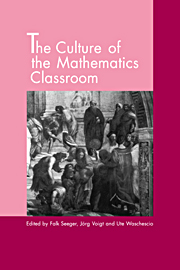Book contents
- Frontmatter
- Contents
- List of contributors
- Acknowledgments
- Introduction
- Part I Changing classroom culture
- Part II Classroom processes
- Part III Epistemology and classroom culture
- 9 The culture of the mathematics classroom and the relations between personal and public knowledge: An epistemological perspective
- 10 Problems of transfer of classroom mathematical knowledge to practical situations
- 11 Cultural perspectives on mathematics and mathematics teaching and learning
- 12 Representations in the mathematics classroom: Reflections and constructions
- 13 Mathematical understanding in classroom interaction: The interrelation of social and epistemological constraints
- Part IV Outlook
- Author index
- Subject index
13 - Mathematical understanding in classroom interaction: The interrelation of social and epistemological constraints
Published online by Cambridge University Press: 03 May 2010
- Frontmatter
- Contents
- List of contributors
- Acknowledgments
- Introduction
- Part I Changing classroom culture
- Part II Classroom processes
- Part III Epistemology and classroom culture
- 9 The culture of the mathematics classroom and the relations between personal and public knowledge: An epistemological perspective
- 10 Problems of transfer of classroom mathematical knowledge to practical situations
- 11 Cultural perspectives on mathematics and mathematics teaching and learning
- 12 Representations in the mathematics classroom: Reflections and constructions
- 13 Mathematical understanding in classroom interaction: The interrelation of social and epistemological constraints
- Part IV Outlook
- Author index
- Subject index
Summary
Understanding as the deciphering of social and epistemological signs
The notion of understanding a mathematical concept or problem plays an important role in any educational investigation of school mathematics, be it in research contexts or in the framework of curricular constructions for the teaching of mathematics. To make possible, to support, and to improve mathematical understanding seem to be central objectives of any theoretical or practical endeavor in the didactics of mathematics.
There is a lot of reflection about how to understand understanding, how to classify different types and degrees of understanding (Pirie 1988; Pirie and Kieren 1989; Schroeder 1987; Skemp 1976), and how conceptually to conceive of understanding (Maier 1988; Sierpinska 1990a, 1990b; Vollrath 1993), and many models describing ideal and everyday processes of understanding mathematics have been developed (Herscovics and Bergeron 1983; Hiebert and Carpenter 1992). Our first step in approaching the puzzling concept of mathematical understanding is to list a number of seemingly contradictory attributes that are associated with this notion.
Understanding is conceived of as an expanding process, gradually improving the comprehension of a concept or problem step by step, and there is never an absolute understanding; on the other side, when being confronted with a new, unsolved problem that seems to be totally incomprehensible, sometimes there is sudden and complete understanding without any further doubt.
Understanding requires one to relate the new knowledge to the knowledge already known, to integrate the unknown into the known; but on the other hand, understanding a new mathematical concept often requires it to be comprehended in itself, without being able to derive the new concept from concepts already understood.
[…]
- Type
- Chapter
- Information
- The Culture of the Mathematics Classroom , pp. 344 - 372Publisher: Cambridge University PressPrint publication year: 1998
- 8
- Cited by



